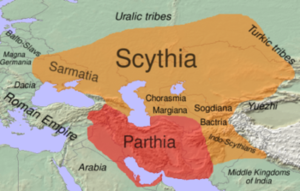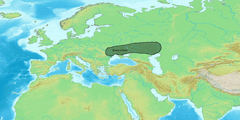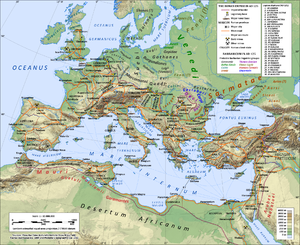سرمت
 الامتداد التقريبي لـ اللغات الإيرانية الشرقية في القرن الأول ق.م. يظهر باللون البرتقالي. | |
| المناطق ذات التجمعات المعتبرة | |
|---|---|
| Eastern Europe Central Asia[بحاجة لمصدر] | |
| اللغات | |
| Scythian languages, East Iranian languages | |
| الجماعات العرقية ذات الصلة | |
| Scythians, Sakas Descendants: Alans, Ossetians Clan Ostoja |
السرمت (Sarmatians؛ باللاتينية: Sarmatae أو Sauromatae, Greek: Σαρμάται, Σαυρομάται) were a large confederation[1] of Iranian people during classical antiquity,[2][3] flourishing from about the 5th century BC to the 4th century AD.[4] They spoke Scythian, an Indo-European language from the Eastern Iranian family.

| جزء من سلسلة عن |
| المواضيع الهندو-أوروپية |
|---|
 |
جزء من سلسلة عن |
|---|
| تاريخ أوكرانيا |
 |
|
|
Originating in the central parts of the Eurasian Steppe, the Sarmatians were part of the wider Scythian cultures.[5] They started migrating westward around the 4th and 3rd centuries BC, coming to dominate the closely related Scythians by 200 BC. At their greatest reported extent, around 1st century AD, these tribes ranged from the Vistula River to the mouth of the Danube and eastward to the Volga, bordering the shores of the Black and Caspian seas as well as the Caucasus to the south.
Their territory, which was known as Sarmatia ( /sɑrˈmeɪʃiə/) to Greco-Roman ethnographers, corresponded to the western part of greater Scythia (it included today's Central Ukraine, South-Eastern Ukraine, Southern Russia, Russian Volga and South-Ural regions, also to a smaller extent north-eastern Balkans and around Moldova). In the 1st century AD, the Sarmatians began encroaching upon the Roman Empire in alliance with Germanic tribes. In the 3rd century AD, their dominance of the Pontic Steppe was broken by the Germanic Goths. With the Hunnic invasions of the 4th century, many Sarmatians joined the Goths and other Germanic tribes (Vandals) in the settlement of the Western Roman Empire. Since large parts of today's Russia, specifically the land between the Ural Mountains and the Don River, were controlled in the 5th century BC by the Sarmatians, the Volga–Don and Ural steppes sometimes are also called "Sarmatian Motherland".[6][7]
The Sarmatians were eventually decisively assimilated (e.g. Slavicisation) and absorbed by the Proto-Slavic population of Eastern Europe.[8]
. . . . . . . . . . . . . . . . . . . . . . . . . . . . . . . . . . . . . . . . . . . . . . . . . . . . . . . . . . . . . . . . . . . . . . . . . . . . . . . . . . . . . . . . . . . . . . . . . . . . . . . . . . . . . . . . . . . . . . . . . . . . . . . . . . . . . . . . . . . . . . . . . . . . . . . . . . . . . . . . . . . . . . . .
أصل الاسم
Sarmatae probably originated as just one of several tribal names of the Sarmatians, but one that Greco-Roman ethnography came to apply as an exonym to the entire group. Strabo in the 1st century names as the main tribes of the Sarmatians the Iazyges, the Roxolani, the Aorsi and the Siraces.
الأصول
الآثار



اللغة
The Sarmatians spoke the Scythian language. The numerous Iranian personal names in the Greek inscriptions from the Black Sea Coast indicate that the Sarmatians spoke a North-Eastern Iranian dialect ancestral to Alanian-Ossetian.[9]
الجينات
In a study conducted in 2014 by Gennady Afanasiev et al. on bone fragments from 10 Alanic burials on the Don River, DNA could be extracted from a total of 7. [مطلوب توضيح][10][مطلوب توضيح]
المظهر
Like the Scythians, Sarmatians were of a Caucasoid appearance. Sarmatian noblemen often reached 1.70–1.80 m (5 ft 7 in – 5 ft 11 in) as measured from skeletons. They had sturdy bones, long hair and beards.[بحاجة لمصدر]
The Alans were a group of Sarmatian tribes, according to the Roman historian Ammianus Marcellinus. He wrote, "Nearly all the Alani are men of great stature and beauty, their hair is somewhat yellow, their eyes are frighteningly fierce".[11]
In the late 2nd or early 3rd century AD, the Greek physician Galen declared that Sarmatians, Scythians and other northern peoples have reddish hair.[12][13]
علم الأعراق اليوناني-الروماني
Herodotus (Histories 4.21) in the 5th century BC placed the land of the Sarmatians east of the Tanais, beginning at the corner of the Maeotian Lake, stretching northwards for fifteen days' journey, adjacent to the forested land of the Budinoi.
الانحدار في القرن الرابع
قائمة القبائل السرمتية
- Alans (sometimes considered separate from the Sarmatians)
- Antes (ethnogenetically mixed Slavic speaking people, see Early Slavs)
- Aorsi
- Arcaragantes and Limigantes, tribes formed after the Roxolani enslaved the Iazyges
- Basileans[بحاجة لمصدر]
- Iazyges
- Roxolani
- Saii[14]
- Serboi
- Siraces
- Spali
- Taifals
- Tyrigetae[15]
. . . . . . . . . . . . . . . . . . . . . . . . . . . . . . . . . . . . . . . . . . . . . . . . . . . . . . . . . . . . . . . . . . . . . . . . . . . . . . . . . . . . . . . . . . . . . . . . . . . . . . . . . . . . . . . . . . . . . . . . . . . . . . . . . . . . . . . . . . . . . . . . . . . . . . . . . . . . . . . . . . . . . . . .
انظر أيضاً
المراجع
الهامش
- ^ Sinor 1990, p. 113
- ^ "Sarmatian". Encyclopædia Britannica Online. Retrieved 31 December 2014.
- ^ Waldman & Mason 2006, pp. 692–694
- ^ J.Harmatta: "Scythians" in UNESCO Collection of History of Humanity – Volume III: From the Seventh Century BC to the Seventh Century AD. Routledge/UNESCO. 1996. pg. 182
- ^ Unterländer, Martina (March 3, 2017). "Ancestry and demography and descendants of Iron Age nomads of the Eurasian Steppe". Nature Communications. doi:10.1038/ncomms14615.
During the first millennium BCE, nomadic people spread over the Eurasian Steppe from the Altai Mountains over the northern Black Sea area as far as the Carpathian Basin... Greek and Persian historians of the 1st millennium BCE chronicle the existence of the Massagetae and Sauromatians, and later, the Sarmatians and Sacae: cultures possessing artefacts similar to those found in classical Scythian monuments, such as weapons, horse harnesses and a distinctive 'Animal Style' artistic tradition. Accordingly, these groups are often assigned to the Scythian culture...
{{cite journal}}: Invalid|ref=harv(help) - ^ "Sarmatian | people". Encyclopedia Britannica.
- ^ Kozlovskaya, Valeriya (2017). The Northern Black Sea in antiquity : networks, connectivity, and cultural interactions. Kozlovskaya, Valeriya, 1972-. Cambridge, United Kingdom. ISBN 9781108517614. OCLC 1000597862.
{{cite book}}: CS1 maint: location missing publisher (link) - ^ Tarasov, Илья Тарасов / Ilia. "Балты в миграциях Великого переселения народов. Галинды // Исторический формат, № 3-4, 2017. С. 95-124". Балты в миграциях Великого переселения народов. Галинды – via www.academia.edu.
- ^ Handbuch der Orientalistik, Iranistik. By I. Gershevitch, O. Hansen, B. Spuler, M.J. Dresden, Prof M Boyce, M. Boyce Summary. E.J. Brill. 1968.
- ^ [1]
- ^ خطأ استشهاد: وسم
<ref>غير صحيح؛ لا نص تم توفيره للمراجع المسماةscribd - ^ Galen. De temperamentis 2. 5
- ^ Day 2001, pp. 55–57
- ^ "Nomads of the Steepes". March 2014. Regnal Chronologies. Retrieved 20 April 2014.
- ^ Prichard Cowles, James. "Ethnography of Europe. 3d ed. p433.1841". 17 January 2015. Houlston & Stoneman, 1841. Retrieved 17 January 2015.
المصادر
- Richard Brzezinski and Mariusz Mielczarek, The Sarmatians 600 BC-AD 450 (Men-At-Arms nr. 373), Oxford: Osprey Publishing, 2002. ISBN 978-1-84176-485-6.
- Davis-Kimball, Jeannine. 2002. Warrior Women: An Archaeologist's Search for History's Hidden Heroines. Warner Books, New York. first Trade printing, 2003. ISBN 0-446-67983-6 (pbk).
- Davis-Kimball, Jeannine, Vladimir A. Bashilov, Leonid T. Yablonsky, Eds. Nomads of the Eurasian Steppes in the Early Iron Age. Berkeley: Zinat Press 1995. ISBN 1-885979-00-2
- Day, John V. (2001). Indo-European origins: the anthropological evidence. Institute for the Study of Man. ISBN 0941694755. Retrieved March 2, 2015.
{{cite book}}: Invalid|ref=harv(help) - Bruno Genito, 1988, The Archaeological Cultures of the Sarmatians with a Preliminary Note on the Trial-Trenches at Gyoma 133: a Sarmatian Settlement in South-Eastern Hungary (Campaign 1985), Annali dell'Istituto Universitario Orientale di Napoli, Vol. 42, pp. 81–126. Napoli.
- Alexander Guagnini (1538–1614), Sarmatiae Europeae descriptio, Spira 1581.
- Sinor, Denis (1 March 1990). The Cambridge History of Early Inner Asia, Volume 1. Cambridge University Press. ISBN 0521243041. Retrieved 16 May 2015.
{{cite book}}: Invalid|ref=harv(help) - Tadeusz Sulimirski, The Sarmatians (vol. 73 in series "Ancient People and Places") London: Thames & Hudson/New York: Praeger, 1970.
- Waldman, Carl; Mason, Catherine (2006). Encyclopedia of European Peoples. Infobase Publishing. ISBN 1438129181. Retrieved January 16, 2015.
{{cite book}}: Invalid|ref=harv(help)
وصلات خارجية
- Encyclopædia Britannica 1911: "Sarmatae"
- Studies in the History and Language of the Sarmatians
- Ptolemaic Map (Digital Scriptorium)
- Map of Sarmatia 1697
- Kurgans, Ritual Sites, and Settlements: Eurasian Bronze and Iron Age
- THE ANONYMOUS PILGRIM OF BORDEAUX (333 A.D.)
- Nomadic Art of the Eastern Eurasian Steppes, an exhibition catalog from The Metropolitan Museum of Art (fully available online as PDF), which contains material on Sarmatians
- CS1 maint: location missing publisher
- Articles with unsourced statements from September 2015
- "Related ethnic groups" needing confirmation
- Pages using infobox ethnic group with unsupported parameters
- Articles using infobox ethnic group with image parameters
- Articles containing Ancient Greek (to 1453)-language text
- Articles with hatnote templates targeting a nonexistent page
- جميع الصفحات التي تحتاج تنظيف
- مقالات بالمعرفة تحتاج توضيح from December 2016
- Articles with unsourced statements from August 2012
- Articles with unsourced statements from March 2015
- سرمت
- شعوب إيرانية قديمة
- المملكة البسفورية
- Ancient history of Ukraine
- شعوب قديمة في روسيا
- جماعات بدوية في أوراسيا
- Iranian nomads
- اللان
- تاريخ شرق أوروپا
- Tribes in Greco-Roman historiography
- Ancient history of the Carpathian-Dniester area
- تاريخ البلقان
- تأسيسات القرن الخامس ق.م. في أوروپا
- انحلالات القرن الرابع في أوروپا
- تأسيسات القرن الخامس ق.م. في آسيا
- انحلالات القرن الرابع في آسيا
- تاريخ الأورال






